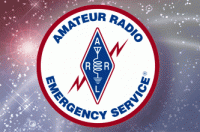|
Welcome,
Guest
|
TOPIC:
Ohio ARES "NVIS Antenna Day" (4/25/15) 8 years 9 months ago #598
|
Ohio ARES "NVIS Antenna Day" Concludes: The Truth is Up There
Ohio ARES NVIS Antenna Day on April 25 attracted participation from some 100 Buckeye State stations in an effort to determine which configurations of near-vertical incidence skywave (NVIS) antenna offer the best results. ARRL Ohio Section Emergency Coordinator Stan Broadway, N8BHL, said that while the results of the unscientific test were inconclusive, some configurations did seem superior to others. Delaware County ARES tried a number of different configurations, several of them using the ubiquitous military mast sections for support: (L-R) Larry Mittman, N9AUG; Emergency Coordinator Donn Rooks, K8AOK; Dave LeMay, WB2CWJ; Dale Bauer, W8KTQ, and Joe Penzera, N8DRZ. "The goal was simple: Try different antennas, see which worked," Broadway explained. "Each station was responsible for providing accurate signal reports, so performance could be evaluated. Results would be tallied and digested in hopes of creating a short list of winners that ARES teams could keep in their toolboxes." Most operation was Field Day-style on 40 meters. "This was not a contest," Broadway pointed out, "so, groups gathered not only to test antennas, but to cook out and enjoy each other's company." He said one group had so much fun making contacts with their first dipole that they abandoned any further antenna work and just had fun. Groups most frequently deployed simple dipoles. End-fed and longwires were popular too, as well as a handful of loops. A half-dozen antennas were based on the military AS-2259 design -- crossed inverted Vs with about 10 feet of elevation in the middle. Other designs included antennas erected above ponds, inverted Ls, and even a Moxon aimed straight up. "For our operation, there just wasn't that much difference between the more specialized NVIS designs and any good antenna," Broadway concluded. The longwire was among those at the bottom of the list, with signal reports uniformly 2 or 3 S-units below other choices, according to Broadway. "But contacts were made, and communication took place," he added. "It's a very portable antenna, too." The Shelby County ARES team fielded a 2259 military-type antenna that worked very well. The center mast was inexpensive conduit, about 12 feet tall, with each of the four legs anchored within a parking lot -- typical of what might be set up in an emergency. Determining the "best" antenna turned out to be harder. Dipoles -- flattops or inverted Vs -- installed at lower heights in keeping with NVIS concepts, provided reasonable reports, but erecting them at a low height didn't seem to make much difference. If any antenna topped the list, it was those fashioned after the AS-2259 configuration. "These all performed very satisfactorily for their owners, and were uniformly given good signal reports," Broadway said. "They weren't 40 dB above the competition, but they were solid." While the NVIS antenna experiment had inconclusive results, "we did prove that our hobby can be a lot of fun, even for the old heads, when we get back to some basics -- experimenting, equipment and team building, and trying our stuff out," Broadway said. Concluded Jefferson County participant Gregory Day, N8GD, "After 34 years, ham radio is still fun!" Ohio ARES is planning an even bigger NVIS event next April, and will extend an invitation to neighboring ARRL sections to join in. Source: www.arrl.org/arrlletter?issue=2015-06-25#toc07 |
|
Please Log in or Create an account to join the conversation.
Last edit: by WA1SFH.
|
Time to create page: 0.149 seconds
